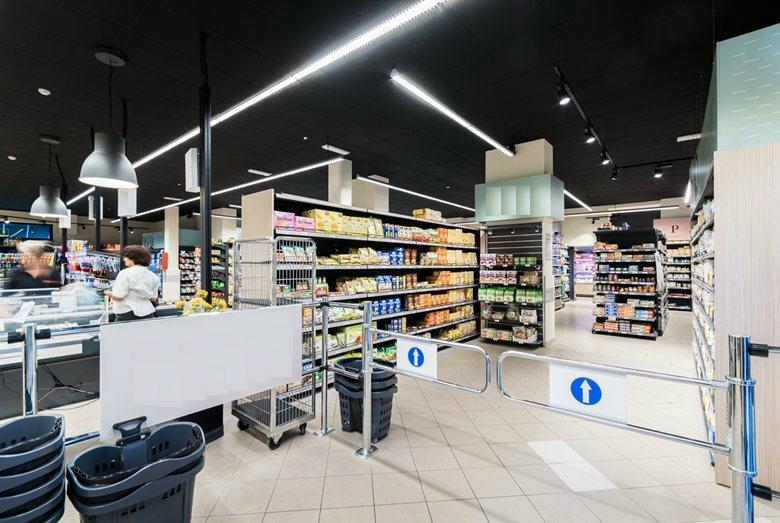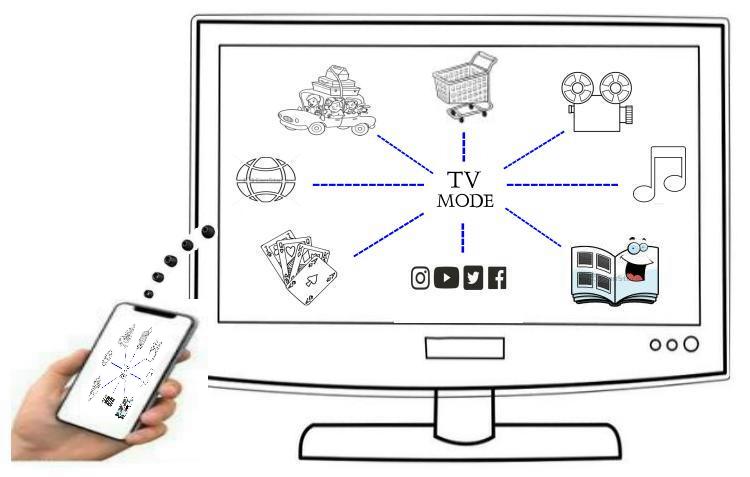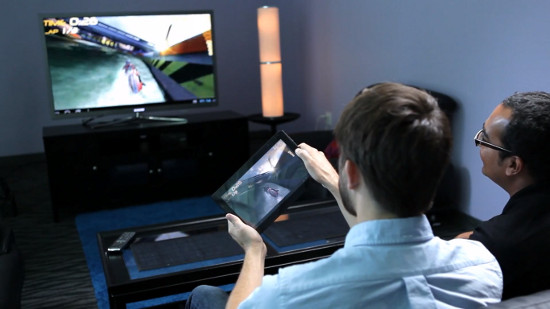
Digital multiservice platform
Project name: TV mode
In this project, as it is easily deductible from the name itself, the TV plays a central role: in fact, it is used to view the tour and contributes to make the whole platform more inclusive, more accessible and multiuser.
It is also possible to use the platform on a smartphone or tablet, losing a little of inclusiveness due to the small size of the device displays compared to the TV.
— application Home

Basic concepts
Each and every operators of the food retail sector have, besides the shopping centers, web sites where it is possibile to shop whatever you need but PC or tablets and informatics basic skills are required and needed.
In those sites, moreover, products are listed by type, price, brand etc. and displayed by pages and this method is extremely demanding for the customer because he hasn’t a clear view of all the products or, at least, not in the same way as it could if he was in front of the shelves of a real supermarket.
The aim of the project is to create an interactive video of a shopping center where the customer can actually walk down the aisles with his cart just like he would in a real supermarket.
With TV mode, in fact, the customer search for the products that he needs on the shelves just like in real life, he takes what he likes from the fridge or from the shelf and he put it straight in the cart; once he has finished his shopping, he heads towards the exit and his groceries will be delivered to his house by a delivery boy in the time period that suits him best.
Thanks to the interactive video, the customer can verify the organoleptic characteristics of the goods, their expiry dates and their country of origin.
Payments can be made on delivery by POS wi-fi or direct debit RID.
TV mode offers the possibility to shop at any hour, to check unhurriedly discounts and offers, to maximise the household budget avoiding waste.
It is possible to solve an unexpected situation such as a sudden dinner or a barbecue because on this platform you can find whatever you need without stress and without wasting time that can be used, instead, to enjoy the evening.
The quality of the footage and the resolution of the TV sets on the market nowadays, make the shopping easier and more enjoyable: without leaving the comfort of your house, you will be projected in a big, appealing, functional, immersive shopping center, just as it happens in a real one.
In addition, given the fact that this project doesn’t require the built of the shopping centers nor the acquisition of building areas nor the building permits, the formation expenses are very reasonable so the offer of the goods is not burdened by financial costs.
Basically, this system gives his time back to the customer.
As previously mentioned, for every other online purchases a PC or a tablet is required but in the case of Tv mode, only a TV and a smartphone are needed: two devices that pretty much everyone has nowadays.
The display of the smartphone is used to interact with the tour, becoming a sort of mouse, as it happens, for example, with the task “street view” on Google Maps.
The use is really simple, user-friendly and suitable for all ages but in case of elderly not so keen on using or on learning new technologies or in case of people with disabilities, an online tutor is supplied to help them and give them advices for the best browsing experience possible.
– why, in particular, the TV?
TV has been chosen because in this way more people can watch the tour simultaneously and on big screen, making grocery shopping more inclusive with the involvement of every member of the family, while sitting on the sofa.

:max_bytes(150000):strip_icc()/GettyImages-screen-mirroring-842272124-5a7897e104d1cf0037763c0a.jpg)
Furthermore, avoid the use of cars to go to the shopping centers reduces the risk factors for accidents and pollutants in the air would decrease; customers can, also, experience a way of buying groceries without having to deal with adverse weather conditions such as rain, fog, snow or ice.
For example, let’s assume that there are 1000 cars Euro 5 with a 100 gr per km of discharge of gas in atmosphere on the streets each day to reach a shopping center and that each one of them covers on average around 10 km, with TV mode, a 1000 kg of pollutants emission would be avoided (not so bad, isn’t it?)
But TV mode is not just a platform for shopping. It can be used, in fact, as a tool for free time:
- Watch together and comment a search on the internet, try to find a solution for the holidays, see the offers, enjoy the gallery on the big screen of a TV
- Share the photo album of your last trip with friends and family
- Share the thought of the moment on your favourite social media
- Watch a movie without the need of decoders, cards or any other annoying installations
- Listen to your favourite music using, maybe, the home theater system of the TV, if present
- It is possible to use it also as voice assistant, so that it will not be necessary to buy other equipments, interface it also with domotic systems and manage all the operations with the sole voice control
Basically, it allows to convert a basic TV into a smartTV ending the troubles of drivers or setups, to provide domotic features and, in particular, to use at will wifi connections or mobile data traffic without any restriction unlike the other solutions present on the market like chromecast or miracast.
Distribution
Distribution among the people is really easy because the customer has just to download the virtual tour, connect the wifi receiver into the television’s slot, everything else is intuitive and simple.
At first, the system is meant for densely populated urban areas in order to plan the deliveries and optimize them neighborhood by neighborhood with the aim of containing costs and delivery times. Then, decentralised distribution platforms will be able to serve smaller towns.
Turnover
It is estimated that the “weekly shop” of an average family of four is approximately 180 euros. If we assume to retain about 4 millions of families and if we suppose that the service is used by 50% of users, the result is pretty simple to obtain and also pretty interesting.
The service can be extended also to small restaurants, pizzerias, canteens that usually spend several hours/people per day for the supply of raw material.
The economic return arising from the service offered to the professional operators is hard to quantify.
Project implementation
To realize the project four main points are needed:
- a software architecture, preferably internal, to develop the virtual tour, the skills, the necessary updates and the management of the streams of the orders
- the acquisition of wireless receiver devices, usb adapter to be provided as loan for use to the customers
- organisation and management of the platforms for the delivery of the goods
- organisation of the delivery staff
Implementation costs (reference to paragraph 5)
The costs at point 1. are quantifiable in the facility, in servers, in operators’ salaries and in the developers.
The costs at point 2. are 4 euros circa by purchasing one. Obviously, by purchasing a few million units, the price will decrease drastically.
The costs at point 3. are variable and they are determined by managerial decisions namely: do we want to use automated warehouse (i.e. Amazon) or do we want to use the traditional ones? Do we want to rent facilities that are already existant or do we want to create new ones? Lastly, we have to add the costs for the management and administrative structure.
The costs at point 4. depend on the company policies.
Thoughts and references
Some of the big retail chains try to retain customers with discounts in a patchy way offering fidelity cards; but what does the “typical customer” ask for?
And, in particular, what do women think about the online shopping?
http://www.unadonna.it/lifestyle/fare-meglio-la-spesa-al-supermercato-e-online/13724/
Giuliano Noci – Politecnico di Milano, Il retail deve ragionare sul lungo periodo
How many Italians use internet to do their shopping?
What do the future retailer think or fear the most?
Last but not least:
the platform is expandable and the service can be extended to third party operators, to rent virtual shop, such as:
- mobile phone shop
- pay tv (it can provide the service using the platform without having to provide a decoder in order to benefit from it)
- online games (allow the use from smartphone without the need to buy additional devices)
See the video
with english subtitles
Current state of this project:
- assessment test done
- this project has a patent
I’m looking for active investors, or rather, people who can provide not only the indispensable and appropriate funds but also the essential business experience to accomplish this project.
Contact:
dinomatello@gmail.com